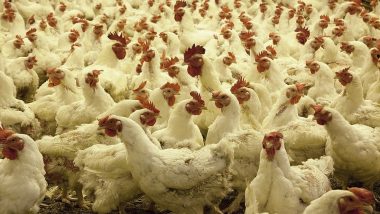Mumbai, December 7: The poultry industry, which was affected due to reports linking chicken consumption to COVID-19, is likely to post healthy profits in the current financial situation supported by lower feed prices and better realisation, according to a report.
The domestic poultry industry has bounced back since June after grappling with a tough period in the last two months of 2019-20 amid rumours linking consumption of chicken to COVID-19, leading to sharp decline in broiler demand and realisations, ICRA said in a report. Also Read | Xiaomi Mi 55-Inch QLED Smart TV to Be Launched in India on December 16, 2020: Report.
According to the report, the healthy rebound since the second quarter of 2020-21 will enable players to post healthy profits during 2020-21 after near washout in profits in 2019-20. This is likely to be well supported by improved realisations and modest feed prices, it added.
Hence, ICRA has revised the credit outlook to stable from negative for the poultry sector as profitability bounces back to pre-COVID-19 levels. ICRA Vice-President Ashish Modani said, "Most of the players had reported net losses in the previous financial year with several smaller players going bankrupt, due to a fall in consumption, high feed prices and modest realisation."
He added that the change in industry scenario for the better since June 2020 has resulted in realisations being at an all-time high currently, this lends support to profitability. "Also, premature culling of chicks as well as lower chick placement during the first quarter of FY21 restricted supplies in the market, which helped in improvement in realisation across all regions during H1 FY21."
In terms of input costs for a poultry farm, feed forms 70 per cent of its variable costs with the balance comprising day old chicks (DOC) cost (20 per cent) and medicinal care, labour and power costs making up for the rest, ICRA stated. Also Read | Vivo Y51 With 5,000mAh Battery Launched in India at Rs 17,990; Check Features, Variants & Specifications.
Within feed costs, by volume, maize forms 60-63 per cent, while soymeal forms 25-27 per cent with the rest being rice bran oil, de-calcium phosphate and other micro-nutrients, it said. The COVID-19-related impact on demand resulted in a sharp decline in maize prices below Rs 13 per kg during the fourth quarter of 2019-20 and the prices remained soft during the first half of 2020-21.
The earlier expectation of maize prices being stabilised following the government intervention by the second quarter of 2020-21 did not happen, thus continuing soft prices has improved players profitability, it said.
On the other hand, the report said that the domestic prices of soyabean after initially crashing in February-April 2020 recovered on the back of strong Chinese demand, re-opening of meat plants and dry weather conditions in some of the key geographies.
The domestic prices have also seen a rise in tune with poultry demand as also following crop damages in key soybean-growing markets like Maharashtra and Madhya Pradesh.
(This is an unedited and auto-generated story from Syndicated News feed, LatestLY Staff may not have modified or edited the content body)













 Quickly
Quickly




















